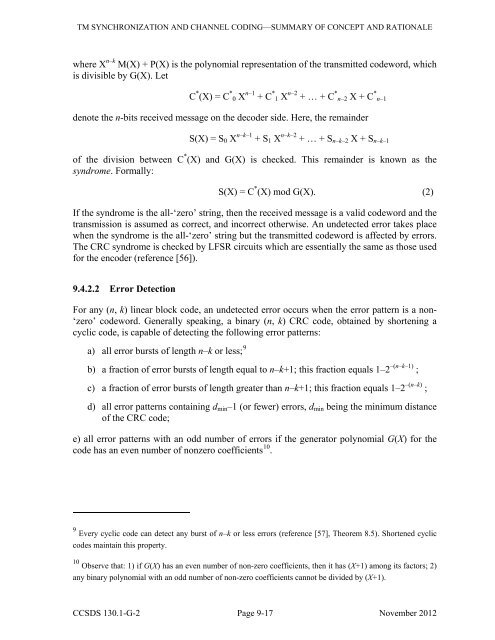130x1g2 - CCSDS
130x1g2 - CCSDS
130x1g2 - CCSDS
Create successful ePaper yourself
Turn your PDF publications into a flip-book with our unique Google optimized e-Paper software.
TM SYNCHRONIZATION AND CHANNEL CODING—SUMMARY OF CONCEPT AND RATIONALEwhere X n–k M(X) + P(X) is the polynomial representation of the transmitted codeword, whichis divisible by G(X). LetC * (X) = C * 0 X n–1 + C * 1 X n–2 + … + C * n–2 X + C * n–1denote the n-bits received message on the decoder side. Here, the remainderS(X) = S 0 X n–k–1 + S 1 X n–k–2 + … + S n–k–2 X + S n–k–1of the division between C * (X) and G(X) is checked. This remainder is known as thesyndrome. Formally:S(X) = C * (X) mod G(X). (2)If the syndrome is the all-‘zero’ string, then the received message is a valid codeword and thetransmission is assumed as correct, and incorrect otherwise. An undetected error takes placewhen the syndrome is the all-‘zero’ string but the transmitted codeword is affected by errors.The CRC syndrome is checked by LFSR circuits which are essentially the same as those usedfor the encoder (reference [56]).9.4.2.2 Error DetectionFor any (n, k) linear block code, an undetected error occurs when the error pattern is a non-‘zero’ codeword. Generally speaking, a binary (n, k) CRC code, obtained by shortening acyclic code, is capable of detecting the following error patterns:a) all error bursts of length n–k or less; 9b) a fraction of error bursts of length equal to n–k+1; this fraction equals 1–2 –(n–k–1) ;c) a fraction of error bursts of length greater than n–k+1; this fraction equals 1–2 –(n–k) ;d) all error patterns containing d min –1 (or fewer) errors, d min being the minimum distanceof the CRC code;e) all error patterns with an odd number of errors if the generator polynomial G(X) for thecode has an even number of nonzero coefficients 10 .9 Every cyclic code can detect any burst of n–k or less errors (reference [57], Theorem 8.5). Shortened cycliccodes maintain this property.10 Observe that: 1) if G(X) has an even number of non-zero coefficients, then it has (X+1) among its factors; 2)any binary polynomial with an odd number of non-zero coefficients cannot be divided by (X+1).<strong>CCSDS</strong> 130.1-G-2 Page 9-17 November 2012

















